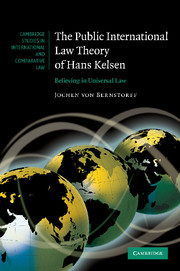Book contents
- Frontmatter
- Contents
- Preface
- Introduction
- PART I The quest for objectivity: the method and construction of universal law
- PART II The outlines of the cosmopolitan project – the actors, sources, and courts of universal law
- Postscript – on Kelsenian formalism in international law (2010)
- Career sketches: Hans Kelsen, Alfred Verdross, and Josef Laurenz Kunz
- Bibliography
- Index
- CAMBRIDGE STUDIES IN INTERNATIONAL AND COMPARATIVE LAW
PART II - The outlines of the cosmopolitan project – the actors, sources, and courts of universal law
Published online by Cambridge University Press: 03 May 2011
- Frontmatter
- Contents
- Preface
- Introduction
- PART I The quest for objectivity: the method and construction of universal law
- PART II The outlines of the cosmopolitan project – the actors, sources, and courts of universal law
- Postscript – on Kelsenian formalism in international law (2010)
- Career sketches: Hans Kelsen, Alfred Verdross, and Josef Laurenz Kunz
- Bibliography
- Index
- CAMBRIDGE STUDIES IN INTERNATIONAL AND COMPARATIVE LAW
Summary
Kelsen had put forth his postulated “purity of method” above all in opposition to the dogma of sovereignty, the voluntaristic foundation of international law, and the dualism of international law and national law. As demonstrated in Part I of this book, his own “objective” construction of international law arose for the most part out of the destruction of traditional doctrinal distinctions, out of the assertion of what had previously been widely seen as impossible. Thus, duality becomes unity, state sovereignty becomes a sovereign order of international law, or a legal system between states becomes a supraordinated law that can directly grant rights to, and impose obligations on, not only states, but also individuals. Behind this revision of traditional doctrine stood, as I will continue to show in Part II, Kelsen's own cosmopolitan project. The outlines of that project become especially clear in his writings during the Second World War that were focused on questions of a new world order. This project included new actors, that is, international organizations and individuals, who take their place next to the state as the classic subject of international law. On the whole, Kelsen sought a thoroughgoing juridification of international relations. Having witnessed two world wars, he advocated a global monopoly of force that was legally controlled and enforced by an effective system of collective security.
- Type
- Chapter
- Information
- The Public International Law Theory of Hans KelsenBelieving in Universal Law, pp. 119 - 122Publisher: Cambridge University PressPrint publication year: 2010



